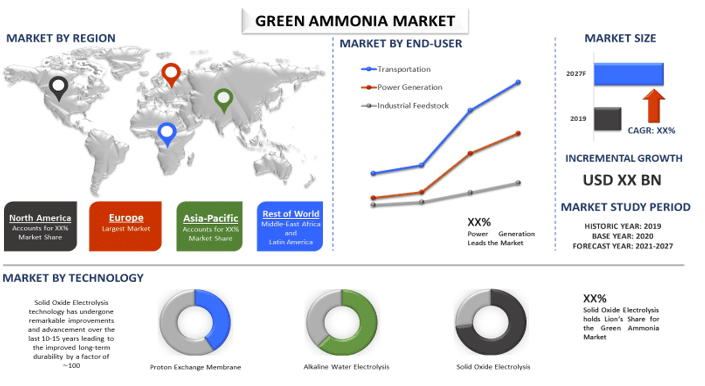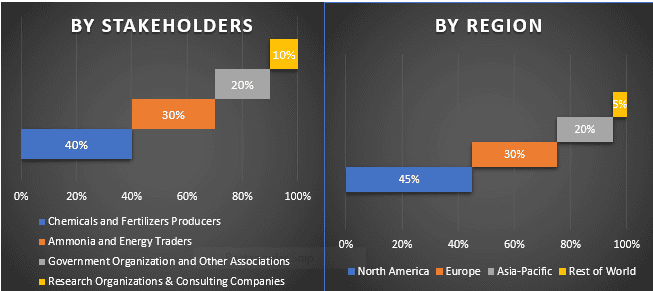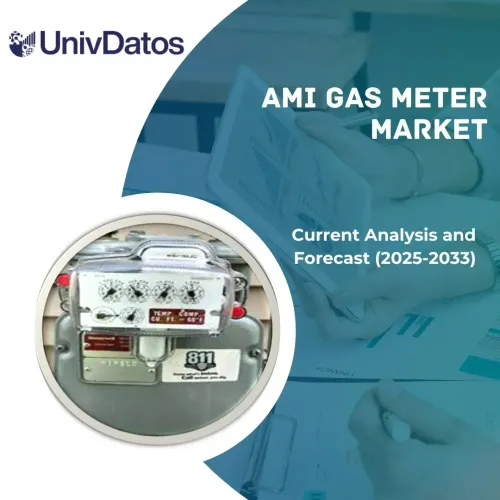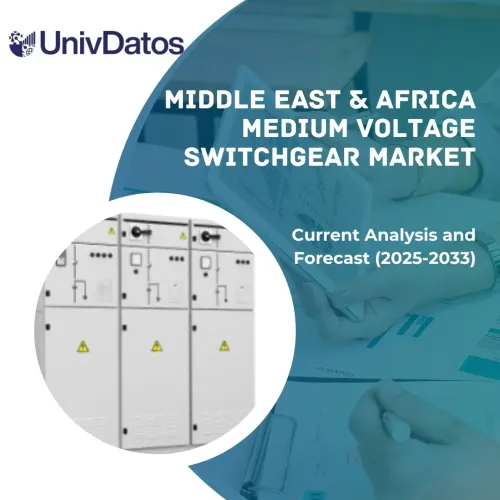- Home
- About Us
- Industry
- Services
- Reading
- Contact Us
Green Ammonia Market: Current Analysis and Forecast (2021-2027)
Emphasis on Technology (Alkaline Water Electrolysis, Proton Exchange Membrane, Solid Oxide Electrolysis); End-User (Transportation, Power Generation, Industrial Feedstock); Region/Country

Global Green Ammonia Market was valued at US$ 11.5 Million in 2020 and is anticipated to reach US$ 215 Million by 2027 displaying an elevated CAGR of 53.5% over the forecast period (2021-2027). Green ammonia is a green way to make ammonia that is a pungent gas used in making agricultural fertilizers. The production of green ammonia is the process of making ammonia that is 100% renewable and carbon-free. One of the most common methods of green ammonia production is by using green hydrogen from water electrolysis.
The world’s air quality is degrading rapidly as the air pollution levels are on the rise across the globe which may pose major health risks to the global population. For instance, as per, the World Health Organization, nearly 7 million deaths are attributed to air pollution every year. Also, 9 out of 10 people breathe air that exceeds WHO guideline limits containing high levels of pollutants, with low- and middle-income countries suffering from the highest exposures. To tackle the degrading environmental changes and their negative impacts, world leaders were legally bound to the Paris agreement in 2015. this agreement was joined by 191 parties and includes commitments from all countries to reduce their emissions and work together to adapt to the impacts of climate change. Owing to these concerns regarding the deteriorating environment and various government regulations for adopting cleaner energy alternatives the green ammonia market is expected to witness growth in upcoming years.
Another significant reason for the growth of this market is the rapid growth in technological advancements leading to the development of an infrastructure that supports environmentally friendly fuels. Consequently, many small and large green ammonia projects are being proposed by many private agencies and governments in various countries including Germany, U.S., Canada, Australia, New Zealand, Chile, Saudi Arabia, among others. For example, Yara, a Norwegian fertilizer maker intends to install electrolyzers to make 3,500 t per year of green ammonia at its plant in Pilbara, Australia.

Siemens, Thyssenkrupp, Nel Hydrogen, Green Hydrogen Systems, MAN Energy Solutions, Uniper, BASF, Enapter, ENGIE, Hiringa Energy are some of the prominent players operating in the green ammonia market. Several M&As along with partnerships have been undertaken by these players to facilitate customers with new and innovative products.
Insights Presented in the Report
“Amongst Technology, solid oxide electrolysis segment holds the major share”
Amongst technology, the global green ammonia market is segmented into alkaline water electrolysis, proton exchange membrane, and solid oxide electrolysis. the solid oxide electrolysis segment of the green ammonia market held significant market share and is likely to showcase considerable growth during the forecast period as SOEC technology has undergone remarkable improvements and advancement over the last 10-15 years leading to the improved long-term durability by a factor of ∼100. further, the initial electrochemical performance of state-of-the-art SOEC single cells has been more than doubled. Owing to these advances and the growing demand for green hydrogen, many global companies are investing in these technologies. For example, Haldor Topsoe will invest in a manufacturing facility producing highly efficient SOEC with a total capacity of 500 megawatts per year with the option to expand to 5 gigawatts per year. This manufacturing facility is expected to become operational by 2023.
“Amongst End-User, power generation segment holds the major share”
Based on end-user, the green ammonia market is segmented into transportation, power generation, and industrial feedstock. Power generation accounted for significant market share in 2020 as ammonia is used in a fuel cell to produce electricity. In a fuel cell, the reaction takes place between ammonia and oxygen present in the air to produce electricity. Furthermore, the increasing share of renewables in power generation and reduction in the cost of equipment and technology associated with renewables is also propelling the market growth.
“Europe represents one of the largest markets of green ammonia market”
For a better understanding of the market dynamics of the green ammonia market, a detailed analysis was conducted for different regions across the globe including North America (the U.S, Canada, and the Rest of North America), Europe (Germany, France, Spain, United Kingdom, Italy, and Rest of Europe), Asia-Pacific (China, Japan, India, Australia, and Rest of APAC), Rest of World has been conducted. Europe dominated the marketbin 2020 owing to the growing popularity of renewable energy and wider adoption of low carbon technologies including green ammonia in the region.
Reasons to buy this report:
- The study includes market sizing and forecasting analysis validated by authenticated key industry experts
- The report presents a quick review of overall industry performance at one glance
- The report covers an in-depth analysis of prominent industry peers with a primary focus on key business financials, product portfolio, expansion strategies, and recent developments
- Detailed examination of drivers, restraints, key trends, and opportunities prevailing in the industry
- The study comprehensively covers the market across different segments
- Deep dive regional level analysis of the industry
Customization Options:
Global green ammonia market can further be customized as per the requirement or any other market segment. Besides this, UMI understands that you may have your own business needs, hence feel free to connect with us to get a report that completely suits your requirements.
Table of Content
Analyzing the historical market, estimation of the current market, and forecasting the future market of the Global Green Ammonia Market were the three major steps undertaken to create and analyze the adoption of green ammonia in major regions globally. Exhaustive secondary research was conducted to collect the historical market numbers and estimate the current market size. Secondly, to validate these insights, numerous findings and assumptions were taken into consideration. Moreover, exhaustive primary interviews were also conducted, with industry experts across the value chain of the Global Green Ammonia Market. Post assumption and validation of market numbers through primary interviews, we employed a top-down/bottom-up approach to forecasting the complete market size. Thereafter, market breakdown and data triangulation methods were adopted to estimate and analyze the market size of segments and sub-segments the industry pertains to. Detailed methodology is explained below:
Analysis of Historical Market Size
Step 1: In-Depth Study of Secondary Sources:
Detail secondary study was conducted to obtain the historical market size of the green ammonia through company internal sources such as annual report & financial statements, performance presentations, press releases, etc., and external sources including journals, news & articles, government publications, competitor publications, sector reports, third-party database, and other credible publications.
Step 2: Market Segmentation:
After obtaining the historical market size of the green ammonia market, we conducted a detailed secondary analysis to gather historical market insights and share for different segments & sub-segments for major regions. Major segments included in the report as technology and end-user. Further country-level analyses were conducted to evaluate the overall adoption of green ammonia across the globe.
Step 3: Factor Analysis:
After acquiring the historical market size of different segments and sub-segments, we conducted a detailed factor analysis to estimate the current market size of green ammonia. Further, we conducted factor analysis using dependent and independent variables such as growing demand for cleaner energy and increasing concerns over degrading environment. A thorough analysis was conducted for demand and supply-side scenarios considering top partnerships, merger and acquisition, business expansion, and product launches in the green ammonia sector across the globe.
Current Market Size Estimate & Forecast
Current Market Sizing: Based on actionable insights from the above 3 steps, we arrived at the current market size, key players in the green ammonia market, and market shares of the segments. All the required percentage shares split, and market breakdowns were determined using the above-mentioned secondary approach and were verified through primary interviews.
Estimation & Forecasting: For market estimation and forecast, weights were assigned to different factors including drivers & trends, restraints, and opportunities available for the stakeholders. After analyzing these factors, relevant forecasting techniques i.e., top-down/bottom-up approach was applied to arrive at the market forecast about 2027 for different segments and subsegments across the major markets globally. The research methodology adopted to estimate the market size encompasses:
- The industry’s market size, in terms of value (US$) and the adoption rate of green ammonia across the major markets domestically
- All percentage shares, splits, and breakdowns of market segments and sub-segments
- Key players in the green ammonia market in terms of products offered. Also, the growth strategies adopted by these players to compete in the fast-growing market
Market Size and Share Validation
Primary Research: In-depth interviews were conducted with the Key Opinion Leaders (KOLs) including Top Level Executives (CXO/VPs, Sales Head, Marketing Head, Operational Head, and Regional Head, Country Head, etc.) across major regions. Primary research findings were then summarized, and statistical analysis was performed to prove the stated hypothesis. Inputs from primary research were consolidated with secondary findings, hence turning information into actionable insights.
Split of Primary Participants in Different Regions
Market Engineering
Data triangulation technique was employed to complete the overall market estimation and to arrive at precise statistical numbers of each segment and sub-segment of the green ammonia market. Data was split into several segments & sub-segments post studying various parameters and trends in the areas of technology and end user of the green ammonia market.
The main objective of the Green Ammonia Market Study
The current & future market trends of green ammonia were pinpointed in the study. Investors can gain strategic insights to base their discretion for investments from the qualitative and quantitative analysis performed in the study. Current and future market trends were determined the overall attractiveness of the market at a regional level, providing a platform for the industrial participant to exploit the untapped market to benefit as a first-mover advantage. Other quantitative goals of the studies include:
- Analyze the current and forecast market size of green ammonia in terms of value (US$). Also, analyze the current and forecast market size of different segments and sub-segments
- Segments in the study include areas of technology and end-user
- Define and analysis of the regulatory framework for the green ammonia industry
- Analyze the value chain involved with the presence of various intermediaries, along with analyzing customer and competitor behaviors of the industry
- Analyze the current and forecast market size of the green ammonia market for the major region
- Major regions studied in the report include North America, Europe, Asia-Pacific and Rest of the world
- Company profiles of the green ammonia market and the growth strategies adopted by the market players to sustain in the fast-growing market
Deep dive regional level analysis of the industry
Related Reports
Customers who bought this item also bought










